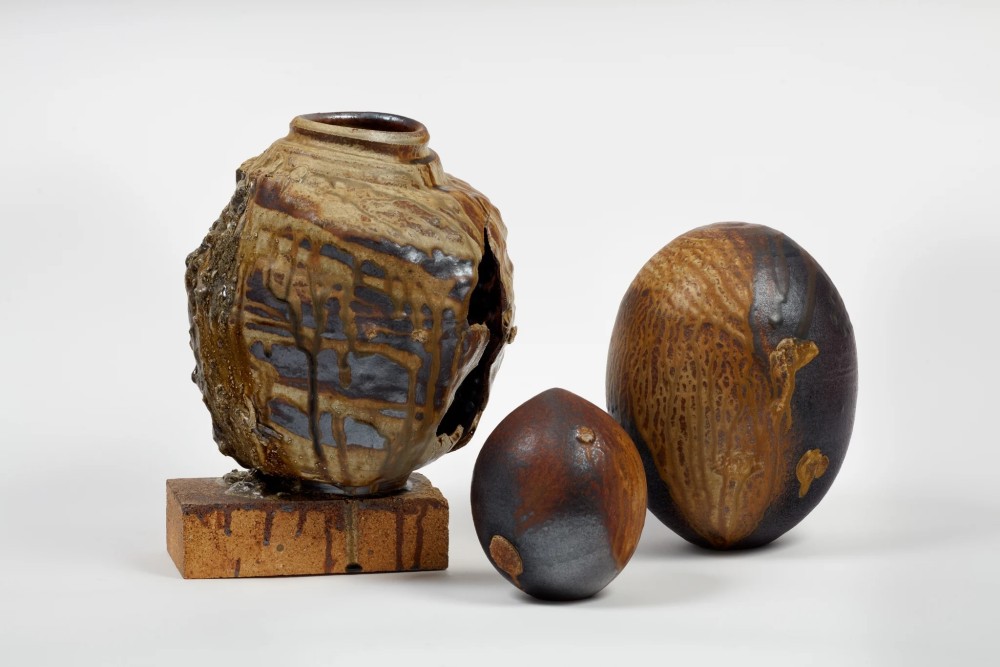
Adam Silverman: LACMA Seeds and Weeds
BLUM is pleased to present LACMA Seeds and Weeds, Los Angeles-based artist Adam Silverman’s first solo exhibition with the gallery.
Continuously finding new ways to address the idea of place through his mastery of the ceramic medium, Silverman has turned to the construction site of the forthcoming Los Angeles County Museum of Art (LACMA) building, designed by Peter Zumthor, for his latest source of inspiration. Collecting remnants such as tar, clay, and felled bamboo trees, the artist processes these tokens into the final constitution of each vessel.
Receiving degrees from the Rhode Island School of Design in both Fine Arts and Architecture, the spatial and structural awareness of Silverman’s artistic output is palpable. As much about their own construction as their relationships to their surroundings, Silverman’s vessels are often presented as elements of a larger installation that also engages its environment—highly considered parts of a whole within a contingent context. After his studies, while doing a residency in ceramics in Mashiko, Japan—known for its rich ceramic tradition—Silverman observed and utilized the local clay that people from this region had been working with for centuries. Those familiar with the traditional vessels from Mashiko would recognize the distinctive style and finish that results, in part, from chemical reactions when firing the iron and silicic acid that naturally occurs in the ground there. It was in Japan that Silverman began examining the connections between pottery’s geological properties and place, but it wasn’t until later that he would begin exchanging geological indicators with cultural meaning in his process.
It was while working on a site-specific installation for the Kimbell Art Museum in Fort Worth, Texas, that Silverman first utilized materials excavated from a cultural site to build his vessels. Intrigued by the convergence of two of his favorite architects, with Renzo Piano’s addition to Louis Kahn’s original museum building, Silverman wanted to create something that encapsulated the physical overlap between these two great cultural forces. Similarly, Silverman saw the construction site of Zumthor’s LACMA building abutting the historically rich La Brea Tar Pits within the heart of the city as a distinct moment of institutional, architectural, biological, and geological relevance that could be preserved through the ceramic medium.
LACMA Seeds and Weeds concretizes a transition for Los Angeles—wherein land that has acted as a gathering point, providing the city a glimpse into its prehistoric past, is peppered with unique properties as a new structure takes its place there. Utilizing materials from the construction zone as part of his medium to create the effect of his finished works, Silverman conceptually honors the many stages of the history of this place in his objects. Carefully searching the LACMA building’s dig site, Silverman found deposits of tar bubbling up from the ground alongside deposits of natural clay. Bringing these substances back to his studio, he processed them—using tools such as a mortar and pestle—into a specific mixture that he utilizes to create the finish of his “seed” and “weed” vessels presented here.
As their name indicates, Silverman’s “seed” and “weed” vessels could almost have cropped up in their location, as that is what the ingredients of their makeup had done. It is Silverman whose expertise allows their specific existence—with a meticulous process that might include multiple firings, restricting airflow to the kiln, or blowing ash on vessels to achieve each work’s unique finish. It is through a combination of what the LACMA site provides and what Silverman alone can cultivate that each work comes into being.
For the work in LACMA Seeds and Weeds, Silverman’s glazes are all made from different combinations of the following ingredients collected from LACMA: wood ash (gallery floors, trees, construction lumber, and debris), concrete, travertine, ceramic tiles, glass, stones, red iron oxide (made from rusty metals found on the site), soda ash, clay, and tar.
Adam Silverman (b. 1963, New York, NY), known for his sculptural vessels, richly expressionistic glazes, and engagement with locally foraged materials, is among the most thoughtful and dynamic practitioners dedicated to ceramics today. Silverman’s training in architecture is often evident in his ambitious installations and the structural clarity and precarity of his objects. He develops and utilizes personal, exploratory techniques to glaze and fire his works. Silverman received a Bachelor of Fine Arts and a Bachelor of Architecture from the Rhode Island School of Design in 1987 and 1988. He lives and works in Los Angeles, CA. Silverman’s work is included in the permanent collections of the Dallas Museum of Art, Dallas, TX; Ibaraki Ceramic Art Museum, Kasama, Japan; Israel Museum, Jerusalem, Israel; Los Angeles County Museum of Art, Los Angeles, CA; Nasher Sculpture Center, Dallas, TX; Nevada Museum of Art, Reno, NV; Palm Springs Art Museum, CA; Rhode Island School of Design Museum, Providence, RI; Shiga Museum of Art, Otsu City, Japan; Skirball Cultural Center, Los Angeles, CA; and the Yale Art Gallery, New Haven, CT.